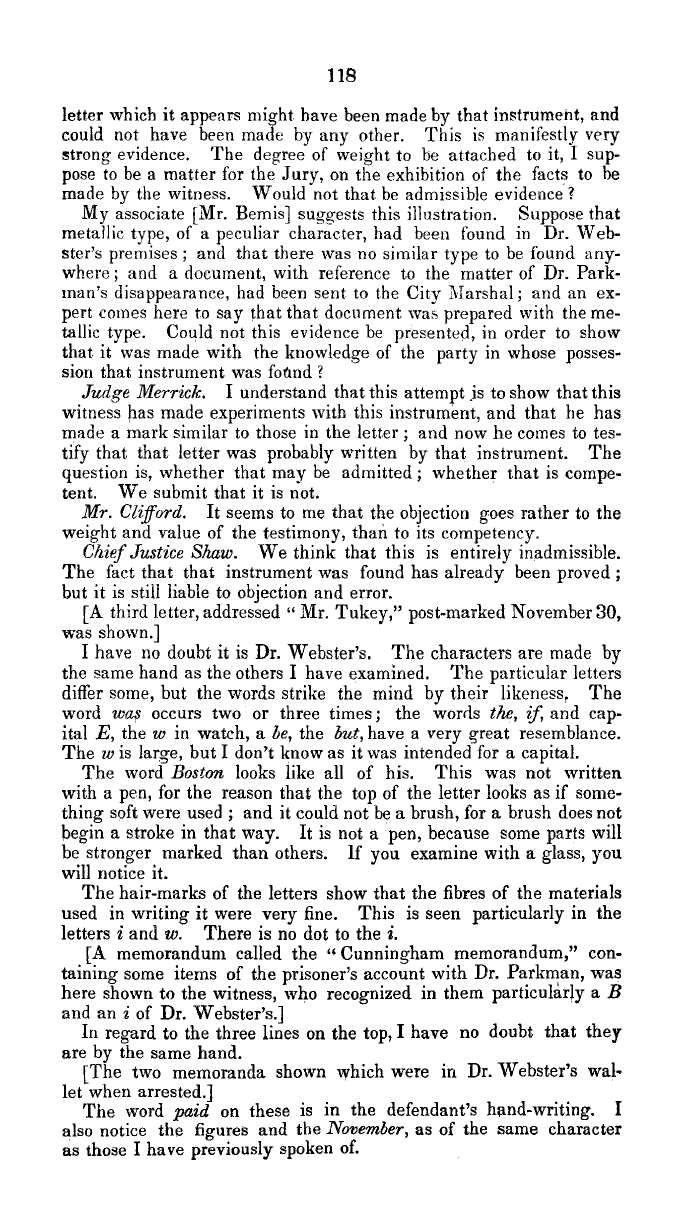|
118
letter which it appears might have been made by that instrument, and
could not have been made by any other. This is manifestly very
strong evidence. The degree of weight to be attached to it, I sup-
pose to be a matter for the Jury, on the exhibition of the facts to be
made by the witness. Would not that, be admissible evidence ?
My associate [Mr. Bemis] suggests this illustration. Suppose that
metallic type, of a peculiar character, had been found in Dr. Web-
ster's premises ; and that there was no similar type to be found any-
where; and a document, with reference to the matter of Dr. Park-
man's disappearance, had been sent to the City Marshal; and an ex-
pert comes here to say that that document was prepared with the me-
tallic type. Could not this evidence be presented, in order to show
that. it was made with the knowledge of the party in whose posses-
sion that instrument was foAnd ?
Judge Merrick. I understand that this attempt is to show that this
witness has made experiments with this instrument, and that he has
made a mark similar to those in the letter ; and now he comes to tes-
tify that that letter was probably written by that instrument. The
question is, whether that may be admitted ; whether that is compe-
tent. We submit that it is not.
Mr. Cliford. It seems to me that the objection goes rather to the
weight and value of the testimony, than to its competency.
Chief Justice Shaw. We think that this is entirely inadmissible.
The fact that that instrument was found has already been proved ;
but it is still liable to objection and error.
[A third letter, addressed °° Mr. Tukey," post-marked November 30,
was shown.]
I have no doubt it is Dr. Webster's. The characters are made by
the same hand as the others I have examined. The particular letters
differ some, but the words strike the mind by their likeness, The
word was occurs two or three times; the words the, if, and cap-
ital E, the w in watch, a be, the but, have a very great resemblance.
The w is large, but I don't know as it was intended for a capital.
The word Boston looks like all of his. This was not written
with a pen, for the reason that the top of the letter looks as if some-
thing soft were used ; and it could not be a brush, for a brush does not
begin a stroke in that way. It is not a pen, because some parts will
be stronger marked than others. If you examine with a glass, you
will notice it.
The hair-marks of the letters show that the fibres of the materials
used in writing it were very fine. This is seen particularly in the
letters i and w. There is no dot to the i.
[A memorandum called the °' Cunningham memorandum," con-
taining some items of the prisoner's account with Dr. Parkman, was
here shown to the witness, who recognized in them particularly a B
and an i of Dr. Webster's.]
In regard to the three lines on the top, I have no doubt that they
are by the same hand.
[The two memoranda shown which were in Dr. Webster's wal-
let when arrested.]
The word paid on these is in the defendant's hand-writing. I
also notice the figures and the November, as of the same character
as those I have previously spoken of.
|

